::: BOSTON LITHOGRAPH - Forgeries :::
|
|
 Back to Boston Lithograph.
Back to Boston Lithograph.
|

|
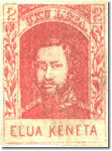
|
|
Taylor Forgery
|
Sperati Forgery
|
|
Two Boston Lithograph forgeries present serious problems for the knowledgeable collector, but the others are rather
obvious. S. Allen Taylor, who perpetrated the notorious Dearborn forgery of the 13¢ Boston Engraved Issue
(see Boston Engraved Forgeries) is also responsible for one of the dangerous
Boston Lithograph forgeries. The other, and far more dangerous forgery, was done by the notorious Sperati. Sperati's
product is identical in all design details to an original stamp. Efforts by Spiro Brothers, Fournier and others are
unconvincing.
All forgeries I have seen are printed on wove paper. The original stamps were printed on laid paper so one test to
distinguish any forgery from the original stamps is to identify the type of paper. The later engraved re-issues of
1869 and 1889 and the official imitation of 1885, were printed on wove paper. All of the forgeries I have seen, were
lithographed. Thus, any lithographed forgery can be distinguished from the engraved issue by identifying the
printing process. In sum, a lithographed item on wove paper is certainly a forgery.
Rogues' Gallery:
Taylor |
Spiro |
Spiro Blue |
Fournier |
Sperati |
 |
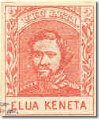 |
 |
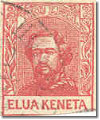 |
 |
|
Taylor "Used" |
Spiro "Used" |
Spiro blue paper |
Fournier "Used" |
Sperati reverse |
 |
 |
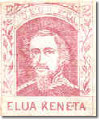 |
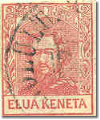 |
 |
|
The Spiro blue and blue paper fakes perhaps are Spiro "knock-offs" because they are cruder even than the "real"
Spiros. Fournier's imitation was used as the Scott Catalogue illustration for decades but is so dissimilar to the
genuine stamp it needs no detail analysis for detection.
The table below compares design details of the genuine stamp with the Taylor and Spiro Brothers forgeries. The Spiro
forgery is included only because it is found so frequently.
The Sperati forgery is described further down the page. Identifying it depends on paper examination rather than
design detail comparison.
Comparison of the Genuine Stamp with the Taylor and Spiro Forgeries:
A. Genuine |
B. Taylor |
C. Spiro Brothers |

Lithographed in various
shades of rose on white laid paper. Outside dimensions are about 25.5mm x 19mm. |

Lithographed in dull red on white wove
paper. Taylor's forgery is 1mm shorter than the genuine and Spiro's fake. The portrait
panel on Taylor is 17mm tall but on the genuine and on Spiro, it is 18mm tall, giving
the Taylor portrait a look of being squeezed into a shorter space. The Taylor side
panels are also shorter by about 1mm. Outside dimensions are about 24.5mm x 19mm. |

Lithographed in red on white wove
paper. The outside dimensions are about 25.5mm x 19mm, the same as the genuine. |
|
|
UKU LETA Panel
A.
 B.
B.
 C.
C.

|
The line above UKU LETA is a give-away. In the original, the line starts above the bottom frame line of the left 2
box and finishes below the bottom frame line of the right 2 box, giving a somewhat steeper right side. Taylor's arc
starts at about the same place but finishes even with the bottom frame line of the right 2 box. Spiro's arc starts
and finishes above the bottom frame lines. The lettering detail is described below.
|
|
|
|
|
Portrait
A.
 B.
B.
 C.
C.
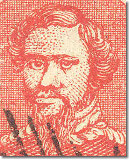
|
We can dispense quickly with the poor imitation by Spiro Brothers. The head seems almost unconnected to the neck it
is at such an odd angle. Other obvious differences between the Spiro forgery and the genuine make it unlikely they
will be confused. Taylor's reproduction of the portrait is much more like the genuine design. But even Taylor made
mistakes on close examination. Taylor's king is looking more squarely to the front. Taylor also gave the king too
much hair on the left side of the stamp. Details of the portrait, described below, give further clues to the
differences.
|
|
|
Forehead
A.
 B.
B.
 C.
C.

|
There are ten lines of dots in the king's forehead on the genuine stamp but only eight on Taylor's. Also, the dots
on Taylor's fake are poorly defined. Spiro's forehead is quite different.
|
|
|
|
On the genuine stamp there is an imperfection to the right of the eye on the right side. Spiro tried to imitate it,
but Taylor missed it. Taylor also made the eye socket too round and his eyes look straight out while the king is
looking to the left (his right). Also, the shade lines around and beneath Taylor's eyes are different than the
genuine.
|
|
|
Nose
A.
 B.
B.
 C.
C.

|
The king's nose is more well defined than Taylor's and a little broader. Spiro gave the king a strange shaped nose,
pointed too far to the left.
|
|
|
Mouth
A.
 B.
B.
 C.
C.

|
Taylor gave the king a little fuller mouth than on the genuine with a thicker, more well defined upper lip and a
thinner lower lip. Spiro gave the king almost no upper lip and a thicker lower lip.
|
|
|
Lower vignette
A.
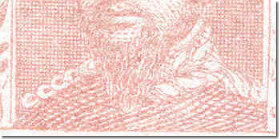 B.
B.
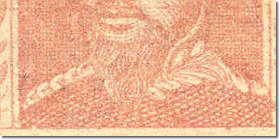 C.
C.
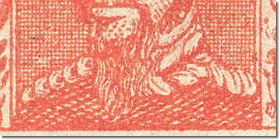
|
Most significantly, Taylor brought the left inner frame line of the portrait panel all the way down to the top frame
line of the ELUA KENETA box where the genuine stamp (and the Spiro forgery) run the shoulder through the inner frame
line to the outer frame line. Details of the leaf design in the collar to the right of the king's neck show
differences and the collar gets lost in the king's hair as it curves up and also gets lost in his beard at the lower
point. On the left shoulder, the epaulet ornaments on the genuine look like donuts. Taylor's look like wide "V's"
and Spiro's are crescents.
|
|
|
Bottom panel
A.
 B.
B.
 C.
C.

|
The "E's" and the "K" on the genuine are unlike the fakes. The other letters have less noticeable differences.
Taylor's bottom frame line has a curve in it at the left end.
|
|
|
Value Boxes
|
Spiro's "2's" are easy to distinguish but Taylor's "2's" are quite good. The left "2" is slightly tilted in Taylor's
fake. On the right value box, the difference in how the line above UKU LETA intersects the right frame line in
relation to the value box is easy to pick up. Spiro's value boxes are slightly longer.
|
|
|
Right panel
|
Taylor's panel is slightly shorter by about 1mm than the genuine but the Spiro panel is equal to the length of the
genuine. Neither Taylor nor Spiro got the leaf ornament quite right and slight differences can be noted.
|
|
|
Left panel
|
Same comments as for the right panel. Also, the leaf at the top of the panel in the genuine stamp touches the bottom
frame line of the value box but neither the Taylor nor the Spiro do. Taylor's right frame line for this panel
extends to the top frame line of the bottom panel where the genuine stop short with a horizontal line connecting to
the vignette frame line.
|
Comparison of the Genuine Stamp with the Sperati Forgery:
A. Genuine |
B. Sperati Print From The Negative |
C. Sperati Forgery |

UR pane, position 23 Diena Flaw position |

|
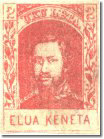
|
Sperati's use of the photolithography process produced the most dangerous of the Boston Lithograph forgeries. In
this process, the forger makes a photograph of an original stamp. In this case, Sperati chose to photograph a
position 23 stamp from the Upper Right pane. That choice proves useful in identifying a Sperati because UR23 is the
unique Diena flaw, so-called because it was first identified by the early 20th Century Italian dealer, Emilio Diena.

|
|
Diena flaw detail
|
|
One finds the Diena Flaw in the right vertical frame line of the UKU LETA box. It probably resulted from a slight
fold in the transfer paper used in laying down the image on the lithograph stone. In any event, if the item being
examined is from any position other than UR23, it is not a Sperati forgery.
Distinguishing a Sperati forgery from a genuine UR23 stamp is done by identifying the paper on which the item is
printed. Instead of producing his forgery on laid paper, Diena used wove paper. As useful as this difference might
seem, it is less so in this instance because Sperati's photograph produced images of laid lines when the item is
viewed from the front. However, when viewed from the back the lines of the laid paper disappear and one sees the
paper is wove, not laid.

|

|
|
Original stamp seen from reverse
|
Sperati seen from reverse
|
As seen in the images above, the lines of the laid paper show clearly on the back of an original stamp. On the
Sperati forgery, there are no laid lines, notwithstanding the appearance of them in the forgery when seen from the
front. In this example of the forgery, Sperati wrote his signature in pencil on the back. Sperati often signed his
products to support his claim that he was producing artistic reproductions instead of attempting to cheat people.
However, not all of his works were signed.
Fortunately, Sperati imitations of the Boston Lithographed stamps are exceptionally rare. No examples were recorded
in the massive inventory of Sperati forgeries done by the British Philatelic Society after purchasing Sperati's
massive stock and tools to remove them from the market. Sperati reproductions also command a market value at least
as high as a genuine stamp, another fortunate circumstance for a collector worried about buying a Sperati instead of
the real thing.
|
|
 Back to Boston Lithograph.
Back to Boston Lithograph.
|
|

|
|
Copyright © 1999 - 2004 POST OFFICE IN PARADISE. All rights reserved.
|